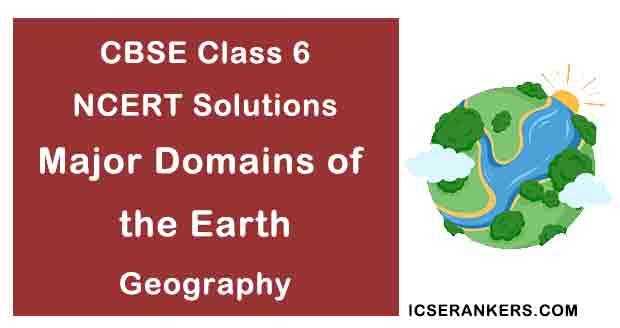NCERT Solutions for Chapter 5 Major Domains of the Earth Class 6 Geography

Chapter Name | Major Domains of the Earth NCERT Solutions |
Class | CBSE Class 6 |
Textbook Name | Geography |
Related Readings |
|
Question 1 A: What are the four major domains of the earth?
Answer
The four major domains of the Earth are:
- Lithosphere-the solid portion of the Earth where we live. Atmosphere-the layer of gases that surround the Earth.
- Hydrosphere-the water present on the surface of the Earth.
- Atmosphere-the layer of gases that surround the Earth.
Biosphere-a small area that contains all forms of life, supported by land, water and air together.
Question 1 B: Name the major continents of the earth.
Answer
Continents are large masses of land on the surface of the Earth. They are separated by large water bodies. There are 7 major continents. They are
- Asia
- Europe
- Africa
- North America
- South America
- Australia
- Antarctica
Answer
When you look at the map of the world, you will observe that most of the continents lie in the Northern Hemisphere. There are only 2 continents that lie entirely in the Southern Hemisphere. They are:
- Australia
- Antarctica
Question 1 D: Name the different layers of atmosphere.
Answer
The thin blanket of gases that surround the Earth is called Atmosphere. The air we breathe is provided by the atmosphere. It also protects us from the damaging effects of the sun's rays. The different layers of atmosphere are:
- Troposphere
- Stratosphere
- Mesosphere
- Thermosphere
- Exosphere
Answer
If you see a globe, you will notice that the color most used in the globe is blue. When seen from space, the Earth appears blue. This is because 71 per cent of our Earth is covered with water. Hence, Earth is called a blue planet.
Question 1 F: Why is the Northern Hemisphere called the Land Hemisphere?
Answer
Most of the continents lie in the Northern Hemisphere. Only 2 continents lie entirely in the Southern Hemisphere. Therefore, Northern Hemisphere is called the Land Hemisphere as a majority of the land lies in it.
Question 1 G: Why is the Biosphere important for living organisms?
Answer
Biosphere consists of the three domains on the Earth, namely, Land, Water and Air. They interact with each other and in turn, have an effect on each other. All the organisms in the Biosphere are dependent on it for survival. Thus, Biosphere is important for all living organisms.
Question 2 A: Tick the correct answer.
The mountain range that separates Europe from Asia is
A. the Andes
B. the Himalayas
C. the Urals
Answer
The Ural mountain range is situated on the western side of Asia. It separates the continent of Europe from the continent of Asia.
Question 2 B: Tick the correct answer.
The continent of North America is linked to South America by
A. an Isthmus
B. a Strait
C. a Canal
Answer
The Isthmus of Panama is the narrow strip of land that links the continent of North America to the continent of South America. It separates Atlantic Ocean from Pacific Ocean.
Question 2 C: Tick the correct answer.
The major constituent of atmosphere by per cent is
A. Nitrogen
B. Oxygen
C. Carbon dioxide
Answer
The major constituent of atmosphere by per cent is Nitrogen. Atmosphere contains approximately 78 per cent Nitrogen. Nitrogen is essential as it helps the living organisms to grow.
Question 2 D: Tick the correct answer.
The domain of the earth consisting of solid rocks is
A. the Atmosphere
B. the Hydrosphere
C. the Lithosphere
Answer
The solid rocks as well as the soil constitute the Lithosphere. The Lithosphere is made up of earth's crust and the different layers of the soil.
Question 2 E: Tick the correct answer.
Which is the largest continent?
A. Africa
B. Asia
C. Australia
Answer
the continent of Asia is the largest contingent on the Earth. Out of the total area of land on the surface of the Earth, it occupies around one third area.
Question 3: Fill in the blanks.
(a) The deepest point on the earth is_______ in the Pacific Ocean.
(b) The_______ Ocean is named after a country.
(c) The_______ is a narrow contact zone of land, water and air that supports life.
(d) The continents of Europe and Asia together are known as_______.
(e) The highest mountain peak on the earth is________.
Answer
(a) The deepest point on the earth is the Mariana Trench in the Pacific Ocean. The depth of the Mariana Trench is approximately 10,994 meters below sea level.
(b) The Indian Ocean is named after a country. No other ocean on the Earth has been named after a country. It is the world's third largest ocean and covers 20 per cent of the Earth's surface.
(c) The Biosphere is a narrow contact zone of land, water and air that supports life. This layer ranges from heights of up to ten kilometers above sea level, to the depths of the oceans. Biosphere consists of the three domains on the Earth, namely, Land, Water and Air.
(d) The continents of Europe and Asia together are known as Eurasia. Most of the continents on the Earth are separated from each other by oceans, but the continents of Europe and Asia are not separated by any water body. They are, therefore, together known as Eurasia.
(e) The highest mountain peak on the earth is Everest. Mount Everest is located on the border of Nepal and Tibet in the Himalayan mountain range. It is 8848 meters above sea level.
